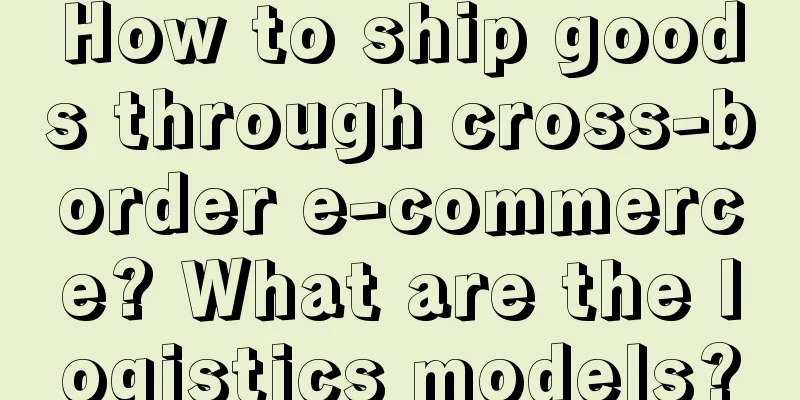How to ship goods through cross-border e-commerce? What are the logistics models?

|
In the field of cross-border e-commerce, efficient delivery is an important part of ensuring customer satisfaction and improving competitiveness. With the integration of global markets and the continuous improvement of consumers' shopping experience, sellers need to master the key steps and logistics models of cross-border e-commerce delivery. So how to deliver in cross-border e-commerce? 1. How to ship goods through cross-border e-commerce? Prepare logistics information First, you need to prepare the logistics information. This includes the weight, size, destination country, etc. By accurately providing this information, it can help the logistics service provider choose the appropriate transportation method and cost, and provide you with a more accurate delivery plan. Choose the right logistics service provider Next, you need to choose the right logistics service provider. In cross-border e-commerce, there are many companies that specialize in providing global logistics services, such as DHL, UPS, FedEx, etc. You can choose the most suitable partner for you based on factors such as price, speed, reliability and coverage of the logistics service provider. Prepare and label your package Before shipping, you need to prepare and mark the package. This includes packaging the goods correctly, using appropriate protective materials and padding to ensure that the goods are not damaged during transportation. In addition, you need to mark the recipient's details on the package, including name, address, phone number, etc. Handling customs and import matters Cross-border e-commerce involves shipping goods between different countries, so you need to be familiar with the customs and import regulations of the destination country. Make sure your products comply with the regulations of the destination country and prepare the necessary documents and certificates to avoid delays or returns. Track and confirm delivery Once the package leaves your warehouse, you need to track the shipment status of the package using the tracking number provided by the logistics service provider. Updating logistics information in a timely manner and sharing this information with customers can increase their trust in their orders and let them know when the goods will be delivered. 2. What are the logistics models? In cross-border e-commerce, there are many logistics models to choose from. Here are some common cross-border e-commerce logistics models: Direct Mail Direct mail means that the goods are mailed directly from the seller's country to the buyer's country. In this model, the seller is usually responsible for the entire logistics process, from packaging, shipping to customs clearance and finally delivery to the buyer. Direct mail is suitable for small items and is faster. Express Agent Express delivery refers to the seller sending the goods to the agent in the destination country, and then the agent will do the final logistics processing and delivery. This model usually has higher speed and reliability, and can provide more tracking and customized services. Warehouse Fulfillment Warehouse delivery means that the seller stores the goods in the warehouse of the destination country, and the warehouse directly ships the goods to the buyer after the buyer places an order. This model can provide faster delivery time and reduce customs-related issues. Ground Shipping If some products are not suitable for air transport, you can also choose ground transportation. This includes land transportation, rail transportation, etc. Although ground transportation is relatively slow, it is usually more economical and suitable for large or heavy goods. In cross-border e-commerce, efficient delivery is the key to ensuring customer satisfaction. Cross-border e-commerce delivery can be carried out effectively by preparing logistics information, selecting the right logistics service provider, preparing and marking packages, handling customs and import matters, and tracking and confirming delivery. At the same time, different logistics models also provide sellers with flexibility and choice. The success of cross-border e-commerce is inseparable from a strong logistics system that can ensure that goods reach customers quickly and safely. Recommended reading: Can Amazon FBA follow-up sales? How to do it? What does the Amazon platform do? How to do it? How long does it take for Amazon to be out of stock? What should I do if it is out of stock for a week? |
<<: What are the standard sizes for Amazon parts? What if they are out of standard?
Recommend
The first batch of "adult dining tables" that swept the entire Internet have closed down
In our daily lives, we are always discouraged by t...
How to enable cash on delivery on Lazada? Related questions answered
The general shopping process on the Lazada platfor...
How to make a brand younger?
Times are changing, and brands need to change too....
Is Shopee cross-border e-commerce profitable? What is the logic behind making money?
Today I will introduce you to cross-border e-comme...
2500-word analysis | The development process of ordinary people becoming personal IP
How can ordinary people become personal IPs? How d...
Wish will launch the "Everyday Black Friday" promotion
Wish merchant platform announced that Wish will la...
What is Shopbop? Is it reliable?
Now that everyone's living standards have impr...
What should I do if my Shopee store traffic suddenly drops? What should I do if there is no traffic when I put my store on the shelves?
Each e-commerce platform is testing the seller'...
As AI creations become increasingly popular and digital humans and virtual anchors emerge, how can guilds and organizations keep up with the trend?
The development of the AI industry has penetrate...
6 tips for new entrepreneurs to help you save 1 million
The main content of this article is to write six a...
Use DeepSeek to make a hit short video, just 4 commands to do it
In the current fierce competition of short videos,...
100 keywords predicted for 2024 | Technological innovation (11-20): new identity, empathy technology, odor digitization, human-machine symbiosis
What will be the key words for development in 2024...
How does Pinduoduo gain popularity? How to do it specifically?
For Pinduoduo stores, popularity is very important...
How long does Shopee's sales volume show? How to get traffic?
Whether you open a store on Shopee or Amazon, ther...
China's own "poor ghost meal" is selling like hot cakes on Douyin
In the era of economic downturn, "poor guy me...









